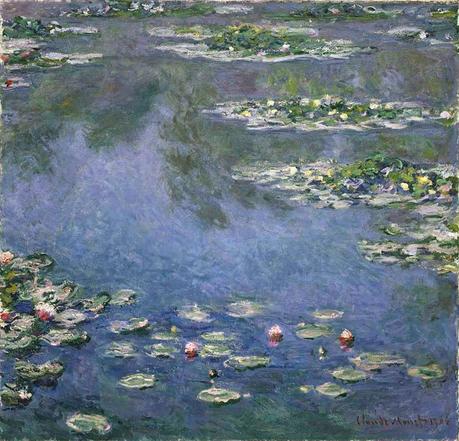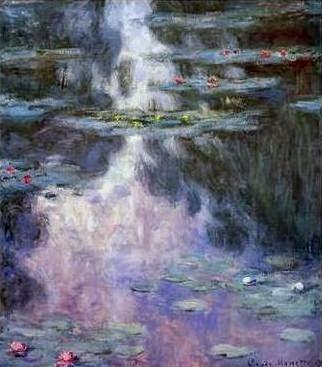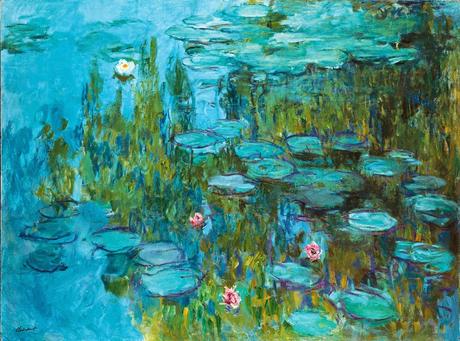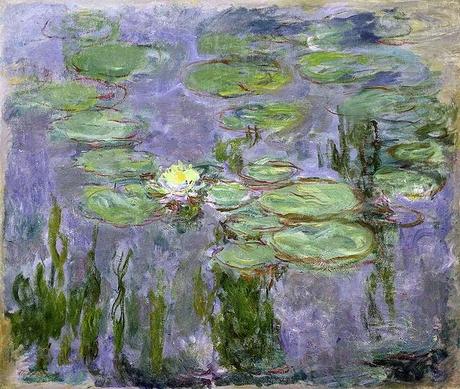
Un particolare divenuto quasi ossessivo, che ritrae il gioco fra i fiori e l'acqua, all'interno del suo giardino di Giverny, allestito dopo il suo trasferimento nel 1882, insieme alla seconda moglie, Alice Hoschedé. Qui, accanto ad una vecchia casa colonica, si occupò di ricreare e curare un giardino ispirato agli spazi verdi nipponici, che prevedesse un ponte, uno stagno e ovviamente delle ninfee.

" [...] giacché il colore che creava in sottofondo ai fiori era più prezioso, più commovente di quello stesso dei fiori; e sia che facesse scintillare sotto le ninfee, nel pomeriggio, il caleidoscopio di una felicità attenta, mobile e silenziosa, sia che si colmasse verso sera, come certi porti lontani, del rosa sognante del tramonto, cambiando di continuo per rimanere sempre in accordo, intorno alle corolle dalle tinte più stabili, con quel che c'è di più profondo, di più fuggevole, di più misterioso - con quel che c'è d'infinito - nell'ora, sembrava che li avesse fatti fiorire in pieno cielo. "
(M. Proust, Alla ricerca del tempo perduto, cit., vol. I, pp. 206-207.)
Ed è proprio grazie al primo impatto visivo, languido e soffuso, come appartenente alla dimensione del sogno, che l'artista sarà in grado di interpretare e tradurre il rapporto tra uomo e natura, utilizzando come chiave, i meravigliosi elementi che la compongono, custodi di una bellezza infinita ed instancabile, a tratti ultraterrena.
Today I'll talk about a painting, or rather, not just one.
This time, the subject is so recurrent in the works of French painter who follows a cycle of 250 paintings, made over 30 years Claude Monet long career.
A particular became almost obsessive, who portrays the play between flowers and water inside his Giverny garden, set up after his transfer in 1882, with his second wife, Alice Hoschedé. Here, next to an old farmhouse, he took to recreate and cure a garden inspired by Japanese green spaces, providing for a bridge, a pond and of course the water lilies.
The master over the years alternated the colors of flowers and water, impressing on his canvases always new meanings and interpretations. The experience and the constant observation of these plants, offer very different landscapes, as if the background should change according to the light of day and night. A point of contact with the sharing poetry of his friend Marcel Proust, who was also a supporter of the role that the impression plays in the work of art, as the highest source of inspiration.
"[...] Since the color that created the flowers in the background was the most precious, the most moving of the same flower; and whether they did sparkle under the water lilies in the afternoon, the kaleidoscope of a happiness attentive, Mobile and silent, whether it colmasse toward evening, like some distant ports, the dreamy pink sunset, changing constantly to stay always in agreement, around corollas hued more stable, with what is deepest, more fleeting, more mysterious - with what there is infinite - the hour, it seemed that had made them flourish in full sky. "
(M. Proust, In Search of Lost Time, cit., Vol. I, pp. 206-207.)
It's thanks to the first visual impact, languid and suffused, as belonging to the dimension of the dream, that the artist will be able to interpret and translate the relationship between man and nature, using as a key, the wonderful elements that make it up, caretakers of infinite beauty and tireless, sometimes otherworldly.







